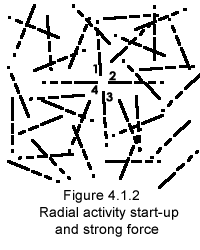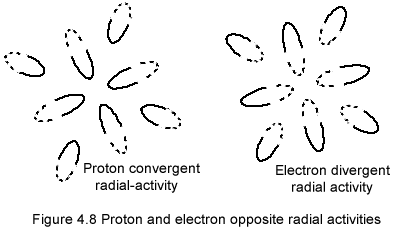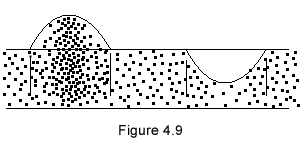Gravity is a fundamental subjacent motion to any existing matter and occurring motion (§4.8)
Because the emergence of all subatomic particles (
figure 4.1.2

) coincides to radial-activity (gravity), and that any motion of matter occurs through radial-activity turned into gravimotion (
Origin of subatomic particles (§4.1)

§4.4
), radial-activity is a subjacent motion to all subatomic particles, material objects, and to all of their motions.Reminder:
No matter the cause of motion, any motion animating matter is radial-activity turned into gravimotion.
Model of free fall or gravimotion (§4.4)
...
As a general rule any material object in motion is in motion through a modification of its inner motion constitution that is its radial-activity.No matter the cause of motion, any motion animating matter is radial-activity turned into gravimotion.
...
Conversely all the subjacent motions listed in
§1.9
are embedded within radial activity.§1.9 reminder:
7. Earth’s daily spin on itself.
6. Earth’s yearly revolution around the sun.
5. The motion of our Solar system within our Milky-Way galaxy.
4. The spinning of our galaxy.
3. The overall motion of our galaxy.
2. ... missing link ... now filled-in in this section §4.8.
1. Finally at the bottom of the stack is pure-activity, as defined in §3.1.
Subjacent motions dislodge the state of rest
For an object on earth the successive subjacent motions are:7. Earth’s daily spin on itself.
6. Earth’s yearly revolution around the sun.
5. The motion of our Solar system within our Milky-Way galaxy.
4. The spinning of our galaxy.
3. The overall motion of our galaxy.
2. ... missing link ... now filled-in in this section §4.8.
1. Finally at the bottom of the stack is pure-activity, as defined in §3.1.
And because radial activity furthermore emerges right out of pure-activity, radial-activity (a motion) fills in the gap that was left unexplained in the subjacent-motions list.
Considering a specific subatomic particle within your own body, called "SP" in the following, the list in §1.9 becomes:
7. The subatomic particle SP is in a rotating motion along Earth’s daily spin on itself.
6. SP is also in rotating motion along Earth’s yearly revolution around the Sun, as the latter is subjacent to Earth's daily spin and SP.
5. SP is also moving with our Solar system within our Milky-Way galaxy,as the latter is subjacent to the above.
4. SP is also spinning along our galaxy, which is subjacent to all of the above motions concerning SP.
3. SP is also in motion through the overall motion of our galaxy, which is again subjacent to all of the above concerning SP.
2. SP is finally its own SP radial-activity (gravitation), which contributes to Earth’s radial-activity, and to the solar system radial activity and on; to start with it is SP's radial-activity that allows the build up of all of the above motions (gravimotions) concerning SP.
1. At the bottom of the stack is the motion, which is the very constitution of the present or pure-activity (space); and out of which SP and Earth's radial-activities (or gravitation) are built.
The most inner motion of any subatomic particle of your own body (motion #2) is radial-activity (an entity in equilibrium) made out of the most frantic motion that occurs that is motion-quanta.
And without subjacent motion #2 there would not be any motion of matter!
None of the embedded motions #3, #4 etc.. including your very own life could occur without #2; as all motions of matter as well as life (motion in time yet dependent on matter) occur through modification of radial-activity or through gravimotion.
Note also that Earth's radial activity (force of gravity in physics), which requires so much motion (energy in physics) to escape, appears way down the ladder of subjacent motions in #2, even though felt by our body as if it was on top.
Proton electron gravitational disparity, mass ratio (§4.9)
Proton and electron common origin mandates they have opposite radial-activities.

Whereas mass doesn’t exist in gravimotion it does in physics.
Even though the proton and electron electric charges are equal in electrical size, their respective gravitational structure and the effect of that gravitational structure are fundamentally different. Before going forward the following must be mentioned:
- In figure 4.9, the representation of the individual MOs and their density graph are represented together. That departs from the idea behind the density graph introduced in section §2.1, in which it is stipulated that density-graph and motion-occurrences are 2 different representations of motion.
- Furthermore in figure 4.9, the proton and electron density representation have rounded tops rather than pointed tops. I do not know whether the "reality" coincides to a triangular density representation or to a rounded one as represented here. This particular representation emphasize the ambivalence as all density graphs in this treatise are drawn with pointed tops.
- Finally pure-activity is represented between 2 horizontal lines, a representation that doesn’t fit infinite present.
 The slopes of the 2 curves, which are coinciding to the proton and electron electrical characteristics, are mirror images of each other (identical charge in physics but opposite sign); yet the respective concentrations and densities of motion-occurrences are greatly mismatched. That density is much higher for the proton than for the electron. A proton includes its own MOs plus some local MOs and MQs. The electron is made of what is left of the local MOs and MQs once it has been established there.
The slopes of the 2 curves, which are coinciding to the proton and electron electrical characteristics, are mirror images of each other (identical charge in physics but opposite sign); yet the respective concentrations and densities of motion-occurrences are greatly mismatched. That density is much higher for the proton than for the electron. A proton includes its own MOs plus some local MOs and MQs. The electron is made of what is left of the local MOs and MQs once it has been established there.The science of physics provides us with the ratio: a proton is 1,800 times heavier than an electron. A proton’s radial-activity would then involve 1,800 MOs for every MO involved in the electron radial-activity.
All in all the displacement of a proton within pure activity involves much more motion-occurrences than the displacement of an electron.
And that, in the eyes of gravimotion, is at the origin of physics mechanical equations that involve mass.